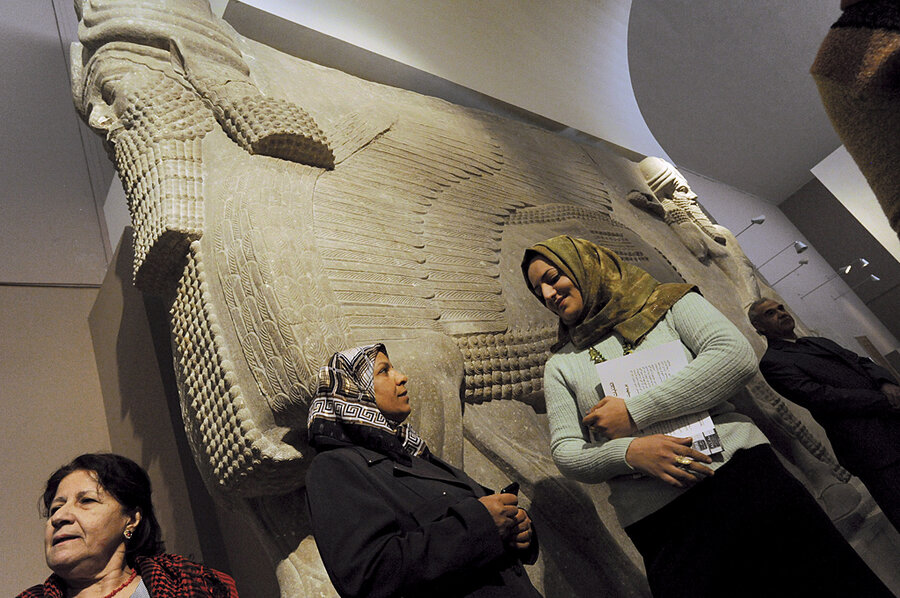Hurt by war in Iraq, a Baghdad museum reemerges
Loading...
| Baghdad
With a snip of red ribbon, a new exhibit opened Nov. 17 at the Iraqi Museum, providing one more sign that Iraq is leaving behind the worst horrors of war and creating a new normal.
"You know what we have been through, and it was very dangerous," says Shaimaa, an archaeologist who has worked at the museum since 1999. "So many things are happening that convince us things are changing for the better."
Among them is the reemergence of her beloved museum, after being devastated by looting early in the war.
"We were heartbroken – it's like someone takes your heart, or takes one of your children. Any human would feel this way," says Shaimaa, who would only give her first name. "But we are optimistic people ... we have turned back, with so much help." Indeed, the transformation at the museum – where 15,400 priceless artifacts were carted away by looters soon after US forces entered Baghdad in 2003 – shows a determined optimism, in a nation where pessimism has become ingrained.
As US forces prepare to fully withdraw from Iraq in the coming weeks – after toppling Saddam Hussein and getting locked into nearly nine years of occupation, insurgency, and sectarian civil war that cost 4,500 American lives and almost certainly hundreds of thousands of Iraqi ones – even small events are taking on unexpected significance.
Abd al-Zahra al-Talakani, of the Ministry of Tourism and Antiquities, notes a burst of cultural events such as music, stage, and drama productions.
"It's very clear," says Mr. Talakani. "All of these activities have returned to Baghdad its real face, and it will be crowned in 2013 when Baghdad will be announced the capital of Arab culture" by the Arab League.
Iraqis often voice their fear that the Iraqi police and Army are not up to the task of maintaining security once American units leave. Iraqis also complain bitterly about the state of national politics, where a newly installed democratic system has been hamstrung by infighting, and gamed by Prime Minister Nouri al-Maliki.
But none of that stopped the Iraqi Museum from unveiling a French-sponsored exhibit Nov. 17 on ancient cuneiform writing in Mesopotamia.
Iraqi staff and officials dressed as if for a gala event and hobnobbed with diplomats while French Ambassador Denys Gauer and Iraqi Tourism and Antiquities Minister Liwaa Semeism cut the ribbon.
Early on in the U.S. occupation, American commanders were criticized for leaving most government institutions like the Iraqi Museum unguarded – making them prime targets for looting – while taking special care to protect the Ministry of Oil.
Priceless artifacts from the museum's incomparable 170,000-lot collection of Babylonian, Sumerian, and Assyrian items disappeared, including the remnants of a 5,000-year-old Sumerian alabaster vase and a headless stone statue of a Sumerian king – thought to be 4,400 years old, and weighing hundreds of pounds – which was recovered in the United States in 2006.
In 2003, senior Iraqi antiquities official Donny George called the looting "the crime of the century because it affects the heritage of all mankind."
Since then, Iraqi officials estimate that a total of 38,000 items have been returned – the majority of them taken from Iraqi dig sites both before and after the US invasion. Some 700 were returned from Syria in 2008; another 540 were recovered in the US and brought back last year.
A further 632 artifacts that had been shipped to the prime minister's office from the US had "gone missing" for most of a year but were eventually found intact in basement offices.
The first problem was the looting. "Whatever was lost, it can't be replaced," says Shaimaa. "Even if it were something small, it will be valuable for us."
The second problem was the lack of security, especially for a government facility just one block away from Haifa Street, which was a notorious area controlled by Al Qaeda in Iraq and marked by violence. "We did not stop working," says Shaimaa, though they did have to work at other ministry facilities "when terrorists were everywhere."
The museum first reopened to the public with great fanfare in February 2009. Eight of its 23 halls remained opened until mid-2010, when it closed again for a complete renovation after money was found for the job.
The scheduled reopening this month will now be delayed at least two months, as work is completed to fit all the halls with new lighting and glass showcases. Until then, the new exhibit will be open to official visits and select students.
But the delayed reopening does not dim the progress for the museum's deputy director, Mohsen Hassan Ali, who says "most of the money" to support the work – about $9 million – has come from the US government.
"Everything" will be put on show, says Mr. Ali, adding that with the "efforts of the good Iraqi people, we have returned much of what was lost, and – God willing – the rest will return."
Just days after U.S. troops pulled down the statue of Saddam Hussein in 2003, Ali – an employee for more than three decades at that point – entered the museum to find it infested with looters. A photograph that appeared in newspapers the next day showed him kicking them out.
"It was a tragic situation," recalls Ali, and the violence took its toll. "The streets were not safe; the neighborhood was not safe. Coming here was very, very difficult."
He lives far away, but when vehicles were blocked by checkpoints or violence, he says, he walked.
Foreign support has helped. Besides the US cash and French sponsorship, the Italians renovated the main hall where the cuneiform exhibit resides.
But what excites Ali more is the fact that in recent years, not only have many stolen artifacts been returned, from inside and outside Iraq, but also that Iraqi archaeologists have been at work "adding to this collection, with new artifacts taken out of the ground."
"Tomorrow will be better, I am sure," says Shaimaa, the museum archaeologist. "The new generation, God willing, will be active and be better."






